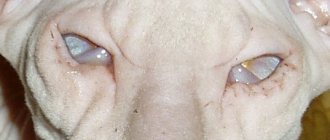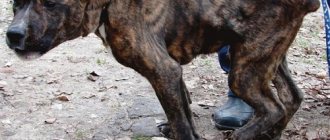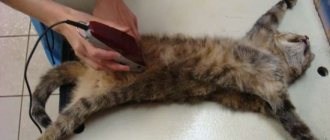Why do hamsters go bald: common reasons
If your hamster's hair falls out quickly, you need to find out the reasons for this phenomenon. Partial or complete change of coat can be caused by shedding of pets. It comes in two types. Age-related molting in hamsters is observed in young animals. Seasonal depends on the time of year. The Djungarik's coat has three shades, but when it is renewed, the number of colors increases to 6.
It is worth noting the following causes of baldness in hamsters:
- Wrong diet choices.
- Allergy to food or cell elements.
- Ticks and parasites.
- Lack or excess of vitamins.
- The first signs of stress are hair loss.
- Hormonal imbalances.
- Poisoning with products containing an excess of pesticides and other harmful components.
- Weakened immunity.
- Improper care and maintenance.
- Attack by other animals.
Problems begin with hair loss on the head, around the eyes and on the stomach. Many hamster diseases are associated with baldness in these areas. There is no need to worry about baldness, as in most cases it is treatable.
An experienced veterinarian can tell you exactly what to do if your pet hamster is itching and going bald. He conducts a thorough examination of the skin with a special lamp. To make a diagnosis, certain tests are taken and skin scrapings are done.
Prevention
The disease is easier to prevent than to treat. With regard to skin diseases in rodents, the following measures must first be observed:
- do not approach the hamster in street clothes and shoes;
- handle your pet with washed hands;
- follow quarantine rules after acquiring a new animal;
- maintain the animal’s home in good sanitary condition;
- protect your pet from stressful situations.
If trouble happens and the pet dies from skin problems, then before purchasing a new hamster you need to do a general cleaning of the room and thoroughly disinfect all equipment and the cage.
The health of pets depends on the owner
Inattention and negligence can destroy even such an unpretentious creature as a hamster
Treatment
Treatment of a bald animal should begin after consultation with a veterinarian. The specialist will prescribe medications that can be used at home.
If the problem is poor nutrition, then the animal should change its diet. Sometimes a special diet menu is prescribed. With proper treatment, the first symptoms of recovery will be noticeable in the first week.
For fungi and viruses, special ointments are prescribed. The composition is applied to the affected areas until the symptoms of baldness disappear completely.
Determining allergies is quite difficult. Changes in the cage, accessories or filler can provoke a negative reaction. In such a situation, it is recommended to thoroughly wash the cage, change the filler and pay special attention to the animal’s nutrition. Wood filler or sawdust should be replaced with paper napkins.
An allergic reaction can be triggered by oats or corn, as well as a monotonous diet. Allergens may include sawdust, dust or rugs. If you suspect that the disease is caused by litter, you should check the paws. In this case, redness is observed.
To eliminate the effects of food poisoning, you can switch to dry food. Fresh vegetables and fruits should be excluded from the diet. You only need to drink filtered water.
If the reason is a stressful situation, the rodent will need to be provided with peace. The cage should be placed in a quiet place.
If several animals live in a cage, then the bald one must be removed. This will prevent others from becoming infected in the event of a fungal or infectious disease. And it will eliminate the possibility of alopecia due to stress if the hamsters do not get along together.
Rodents age early and begin to lose their fur at the age of two years. In such a situation, you can only surround your pet with care and pamper him with delicious treats.
Allergy
If your Djungarian hamster is itching, this does not mean that he is sick. Perhaps this is how he manifests an allergic reaction. The cause of itching and scratching can be anything - bedding, food, new products, detergents, air freshener.
When an allergy occurs, the Djungarian hamster not only itches, but also sneezes. The scratches are deep, sometimes ulcers appear on the surface of the skin.
What to do in this case? First of all, you need to exclude newly introduced foods from your diet. If the symptoms do not go away, you need to completely replace your usual diet with a dietary one. You should also move your pet to another cage and change the bedding. The best option in this case would be a layer of napkins or toilet paper. The main thing is that the material is white, without any inscriptions, drawings or flavors.
Why does a hamster lose hair?
The problem of partial or massive hair loss in rodents can be caused by disease or poor care. Any breeder can face the loss of a fur coat, and the issue of baldness becomes especially pressing in winter.
Caring owners, faced with hair loss in rodents, begin to look for reasons in the care and organization of the pet’s diet, suspecting them as key factors in baldness. There is some truth in this, but you should not rush to blame yourself for the wrong approach to the animal, since the reasons can also be caused by skin diseases, independent of the quality of care. Prompt response to the problem will significantly increase the chances of successful treatment of the rodent, so it is important to know all the possible sources of ill health. Chief among them:
- Fungal or viral infection.
- Infection with a tick or subcutaneous parasite.
- Food with a high content of chemical additives, which are used in industry to increase shelf life.
- Manifestation of an allergy to a certain food or a new object in the cage.
- Lack or excess of vitamins.
- Individual intolerance to filler components.
- Severe food poisoning.
- Stressful situations that can be caused by a radical change in diet, excessive attention or innovations in the cage (rearrangement or addition).
- Physiological changes due to the age of the rodent.
- Weak immune system.
- Taking hormonal drugs.
- Irregular knitting.
- Attack by other domestic animals.
Most often, hair loss in rodents, including the Djungarian hamster, begins from the head, eye area and tummy. It is not uncommon for hamsters' paws to become exposed first. If you begin to notice hair loss, inspect these areas first to be sure to determine the presence of the disease.
There is no need to worry about baldness, since in most cases it can be successfully treated. The only exceptions are elderly animals, in which the processes are associated with the approach of death. Common causes include fungi, parasites, and poor rodent nutrition.
If your hamster's hair is falling out and there is damage to the skin, it is necessary to take him to see a veterinarian for a detailed examination and diagnosis. It is advisable not to delay going to the clinic, stretching out the start of treatment for several days. We have clarified what to do if a hamster’s fur begins to fall out and it’s time to find out how to cure the animal.
Shedding
A complete or partial change of coat is called molting. It has two varieties:
- Age - young animals develop denser hair instead of a soft fur coat. The process usually occurs unnoticed by the owner, at the age of about four months.
- Seasonal – associated with the seasons. Spring and autumn molting are most typical for animals. If they hibernate in winter, they shed their fur in summer.
Regarding hamsters, it is impossible to say for sure whether they shed. Of course, the fur is renewed, and if the rodent is healthy, its owner does not even notice it. But in many ways this process depends on hereditary factors and conditions of detention.
If the hamster is healthy, then fur renewal is a completely natural process.
If your pet is losing hair, keep an eye on him. Is he active, eating well and not itchy? Most likely it's molting. If you wish, you can do a visual test - blow on the fur and carefully examine the hair. For example, in Djungarian hamsters it has three colors, and when the fur is renewed, their number increases to six.
Diagnosis of rodent diseases
If you yourself were able to determine why your hamster’s hair is falling out and found the source of the unpleasant causes, immediately remove the irritant and observe the animal’s further reaction. The situation when a pet has suffered baldness due to intolerance to the bedding or material renewal in the cage can be quickly corrected without serious consequences.
If your hamster has eaten previously unfamiliar foods or low-quality food, return him to his previous diet and make sure that the food is fresh and of decent quality. By eliminating allergens, the hamster will soon recover. When the reasons lie deep and only a specialist can determine them, do not waste time and seek veterinary help.
Possible diagnoses and treatments:
- Poor or unhealthy diet. If the cause of the disease lies in the rodent’s diet, the doctor will recommend changing the diet, and in some cases will prescribe a separate dietary menu for the rodent. This could be a diet with lots of greens, with a variety of nutritional supplements that the animals can eat. Correct diagnosis and timely treatment will allow the animal to become healthy within a month. The first signs of a successful cure appear already in the first week: the development of the disease stops, and the bald parts of the skin begin to grow with new fuzz.
- Fungi or viruses. They are characterized by symptoms when the animal's skin peels off, accompanied by hair loss. When an infection of this nature is detected, rodents are prescribed special ointments, which can be easily purchased both in the clinic itself and in veterinary stores. The ointment is regularly applied to the affected areas of the skin until the signs of baldness disappear. In order to consolidate the result and prevent it, you can repeat the application of the ointment several times even after the rodent has recovered.
- Allergic reactions. It is quite difficult to detect the cause of the allergy, so the doctor will ask you to remember the next few days before the onset of the disease. This could include possible changes in the cage (new litter or toys), as well as the rodent’s diet in detail. By the way, at the first symptoms of baldness, it is important to ask yourself such questions. If the animal is offered a different filler, replace it with the same one and thoroughly wash the cage. Preferably with a disinfectant to eliminate residual reactions. Do not use chlorine because it is harmful to the animal. Pay detailed attention to your hamster's nutrition. To eliminate food poisoning, you can temporarily switch your animal to dry food.
- Stressful situations. If a hamster loses its fur, but there are no other reasons why the animal began to go bald, stress may be to blame. The rodent will need absolute rest. Place the cage in a quiet place, try to rid the animal of sharp and loud sounds. Give him a good rest, including from your own attention. The animal needs time to get back to normal.
- Age-related changes. Unfortunately, rodents age very early and already at the age of 2 years show the first signs of impending death. Some individuals begin to lose fur at a slightly earlier age. In this case, nothing can help the animal. Try to surround him with care and pamper him with delicious treats, making his days carefree and cozy.
Hair loss can be avoided through a balanced diet. Feed your rodent high-quality foods, add vitamins to the diet, but do not forget that their excess can have unpleasant consequences. Create favorable and comfortable living conditions for the animal: regularly wash the cage, offer toys for an active lifestyle and make sure that the animal is not exposed to stress. Surrounded by care, the hamster will feel great, delighting its owner with vigor and good health.
>
The hamster has spots
How to prevent baldness
To avoid possible hair loss, provide your pet with comfortable living conditions. Protect him from stress, offer toys for an active lifestyle. Keep the cage clean - wash it regularly and change the bedding. A correct and balanced diet is very important: only high-quality products should be on the menu, periodically give the animal vitamins, but do not overdo it. If you surround your hamster with love and care, he will feel great and delight you with his health and good mood.
The hamster has spots. What could it be?
Owners quite often notice black spots on their hamster’s body. Don't rush to sound the alarm. These spots may not always be dangerous to the life and health of the animal. Black symmetrical spots on the sides are scent glands.
Syrian and Djungarian hamsters use scent glands to mark their territory. Their size and color may vary. The spots on hamsters can be large and prominent, and in some they can be very small and unnoticeable. Some owners do not notice these spots at all and this is quite normal.
In males, the scent glands are much more pronounced. They are convex and have a slight roughness. Sometimes rodents rub against the bars of the cage. At this point, you can notice that their sides are wet. In this way they mark their territory or try to attract the attention of the female. This is a natural phenomenon. There is no reason to worry.
If your hamster's black spots change, you should consult a doctor. Changes may indicate stress, inflammation, or even cancer in the animal. Only a veterinarian can make a correct diagnosis after a complete examination. Treatment can be either medication or surgery.
In Djungarian hamsters, the location of the scent glands is slightly different. A hamster has spots on its tummy. They are present only in males. They mark their territory by scratching their bellies. Try to remove all sharp objects from the cage so that the animal does not get hurt.
What to do if your hamster has spots?!
If you notice a red spot on your hamster, you should contact your veterinarian. These can be various skin diseases. They pose a great danger to small pets. Treatment of skin diseases should begin when the first symptoms appear. Weakness, partial refusal of food and water, bad mood, drowsiness. This can be lichen, dermatitis, damage by ticks, fleas and other parasites.
The spots on a hamster's skin are not always scent glands. These could be skin diseases, inflammatory processes or even oncology. This is all very serious for a rodent. Hamsters are very susceptible to diseases.
The diseases develop very quickly and become severe. That is why you need to immediately contact a veterinary clinic.
Don't delay. You can call a qualified specialist to your home. He will provide you with high-quality medical care and preserve the life and health of your animal.
When a charming furry pet begins to lose hair, the owner’s natural desire is to quickly understand why the hamster is going bald. There are so many possible causes that it is best to consult with your doctor before starting treatment.
Hair loss associated with skin inflammation is always accompanied by itching. If your hamster itches and goes bald, you must first rule out parasites.
How can I help my fluffy?
The main thing is to pay attention to the itching animal in time. Of course, you won’t be able to diagnose the disease yourself.
The first thing you need to do is isolate the itching hamster. The veterinary clinic must take skin scrapings from your pet, possibly fragments of fur, and use them to determine the presence of a particular parasite. If there are no parasites, the hamster may be suspected of having an allergy.
A veterinarian must prescribe drug treatment for a hamster, because due to its miniature size, the animal needs minimal doses of medication, which is not always possible to calculate independently. Stronghold drops are excellent for killing ticks. To get rid of fungus, bathing in special shampoos and treatment with antifungal ointments are suitable. It is imperative to disinfect the cage to destroy tick and flea eggs or fungal spores.
Infectious skin diseases
Scabies
Most often, baldness in hamsters is caused by parasitism of subcutaneous mites. With advanced demodicosis, the animal loses up to 90% of its fur. The skin looks not just bare, it is inflamed, thickened, with traces of scratching. The hamster itches, squeals in pain, behaves aggressively, and does not allow you to pick it up.
Inexperienced owners believe that allergies are one of the most common reasons why hamsters go bald. By changing food and filler for a long time, they lose time, and demodicosis takes a generalized form. Allergies do occur in hamsters, but they are more often manifested by rhinitis and conjunctivitis than by skin problems.
When the Djungarian hamster goes bald, the veterinarian will begin treatment against the subcutaneous mite, even if the parasites could not be seen in the skin scraping. It is difficult to get a good scraping from a small, nimble rodent that cannot be properly fixed.
hamster scabies
Treatment: Otodectin (0.1% ivermectin) subcutaneously at intervals of 7-14 days, 2-4 injections, up to 6 times if the problem is advanced. Dose 0.2 ml per 1 kg of weight. The Syrian hamster weighs approximately 150 g; such an animal is given 0.03 ml of otodectin. Dzungarik weighs about 50 g, its dose is 0.01 ml.
Lichen
Fungal skin diseases are characterized by peeling of the skin, chronic course and itching. The hamster, as with demodicosis, becomes bald and itchy, but the hairless areas of a regular round shape are limited. The skin is not completely bare, covered with a crust, and the hair seems to be broken off at the root. Ringworm can be treated over a long period of time using antifungal ointments and sprays. Fortunately, it is rare.
hamster has lichen
Allergy
Allergies can be food or contact. A food problem occurs when improper feeding occurs, when the hamster receives food “from the table” - sweet food, nuts, strawberries and other exotic delicacies. Contact – for household chemicals, filler (coniferous sawdust). If the animal sits in the owner's arms, it may be allergic to perfume.
When allergies occur, not only the animal’s skin is affected - the ears turn red, transparent discharge appears from the eyes and nose, and the animal may sneeze.
Treatment does not require the use of antihistamines; it is enough to identify and remove the cause. The bedding is replaced with white paper napkins, and all excesses are removed from the diet.
Secondary alopecia
If the animal suddenly begins to go bald, and the skin looks clean and smooth, the reason is not parasites (mites, fungi). With alopecia that is not caused by problems directly with the skin, the hamster does not itch.
Abscess
If limited purulent inflammation occurs, the skin in this area becomes thinner and the hair falls out. Baldness is accompanied by a change in skin color, the focus fluctuates when palpated. An abscess in a hamster opens spontaneously or in a veterinary clinic.
In addition to surgical treatment, a course of antibiotics and daily washing of the wound with an antiseptic are required. Prescribe “Baytril 2.5%” 0.4 ml per 1 kg of body weight (0.06-0.1 ml for Syrians and 0.02 ml for dwarfs). Subcutaneous injections, 1 time per day, 7 days.
The fur grows back after the purulent inflammation stops.
abscess in a hamster
Urine irritation
If your hamster's hind legs and tummy are bald, this indicates constant skin contact with urine. Infrequent bedding changes and a small cage will cause this phenomenon, but if the pet is kept properly, hair loss on the pelvic limbs is a sign that the hamster drinks a lot and pees a lot. Polyuria is a symptom of various diseases:
- Cystitis (inflammation of the bladder);
- Urolithiasis disease;
- Kidney failure;
- Diabetes (in dwarf hamsters).
hamster urine irritation
Mechanical abrasion of wool
Under unsuitable conditions, thick fur may fall out due to constant mechanical stress. This is how the hair on the paws and tummy is wiped, but most often on the head if the hamster has a bad habit of gnawing on the bars of the cage. The bald spot on the nose will not heal until the pet stops sticking its muzzle through the bars.
If it is not possible to move the rodent from a lattice cage to a terrarium, you need to offer it another object for grinding down its constantly growing incisors. Twigs, treats for hamsters in the form of hard sticks, mineral stone. You should not humanize the animal by thinking that it is gnawing on a cage in order to break free.
Hormonal alopecia
Sometimes, to understand why a hamster is bald, the animal needs an ultrasound. This is not possible in every clinic. An experienced ratologist can assume disruptions in the hormonal system if baldness is observed in a female, and the bald spots on the back are symmetrical. Hamsters have:
- Polycystic ovarian tumors and tumors;
- Endometritis, pyometra (inflammation of the uterus).
hormonal alopecia in a hamster
A female can also go bald during pregnancy. The belly of a nursing hamster becomes completely naked during lactation.
Shedding
Bald spots can be a sign of a natural process for hamsters - seasonal molting. Baldness usually affects the stomach and inner thighs, but sometimes hair falls out on the back.
Old age
If an old hamster begins to go bald, and parasitic diseases are excluded, the true cause can rarely be determined. In such a situation, we can only advise adding special vitamins for rodents to the food and ensuring ideal living conditions.
You can’t say in absentia what to do if your hamster is going bald. To find out the cause, in most cases it is necessary to examine the animal by a specialist and conduct special studies. If the hamster has begun to shed its fur, then the owner’s task before taking a ratologist is to provide the pet with balanced, nutritious nutrition and optimal living conditions.
Causes of baldness in hamsters 5 (100%) 9 votes
The hamster is going bald, we try to treat it ourselves
But, if you can’t turn to a specialist right now, you will have to treat your pet for baldness yourself. Let's look at the possible causes of the disease in order.
Allergy
The litter can serve as a source of infection and quite often leads to allergic reactions in hamsters, which can subsequently cause baldness. The filler can be replaced with regular paper napkins or towels.
To eliminate the possibility of an allergy to the contents of the cage, carry out a general cleaning of it. To begin, remove all contents, litter, branches or stones, and other toys of your pet from the cage. All porous items should be thrown away and replaced with others.
Thoroughly disinfect everything your pet comes into contact with, and also treat the animal’s home! Buy a disinfectant at a specialized pet store and be sure to follow the instructions for using the product.
The use of household chemicals is also allowed. Leave objects that the hamster has come into contact with in the solution for several hours, and then rinse them thoroughly under a strong stream of water.
It would be wrong to use antifungal ointments, and therefore to advise them, because without a thorough analysis it is not possible to establish the cause of baldness. This means that treatment with ointment will most likely not be correct.
Remember, using any medication without consulting a veterinarian can lead to negative consequences, including the death of the animal.
Food poisoning
It is necessary to adjust the rodent's diet. First, you need to exclude fresh fruits and vegetables from your diet. During this period, it is recommended to feed the hamster only with previously tested dry food. Drink exclusively clean filtered water.
Stress is the cause of baldness
The cause of baldness is often stress; the reason for it can be, for example, moving the cage to another place or “sharing” your pet with a neighbor.
Remember, most hamsters do not like company and do best alone. And when a neighbor imposes stress, both rodents will feel stress; the consequence of such stress can also be baldness of the hamster.
A fairly common cause of baldness in hamsters is lichen. With this disease, scales and wounds may form in areas of baldness. It is quite difficult to identify lichen at an early stage; the skin is not immediately affected and visually lichen appears a couple of months after the pet is infected.
To treat this disease, there are a huge number of ointments and creams against lichen, but if this particular disease is detected, we still recommend contacting a veterinarian and immediately isolating the animal.
Well, one last thing: age. Depending on heredity and breed, the life expectancy of a hamster is no more than two years. By that age, there is a likelihood of health problems occurring, in particular the hamster’s baldness. Under such circumstances, it seems little possible to make his life easier. Using a new diet may help correct the situation.
The hamster is going bald, causes, symptoms, prevention, treatment 3.4 (68%) 5 votes
Causes of loss
A healthy and active hamster loses its hair
If the animal behaves as usual, it moves actively and eats well, but the owner notices that its fur is simply “falling off,” then perhaps it’s all about molting. Seasonal coat changes are typical for animals in the wild.
In indoor conditions, this process is more extended, although very often it goes almost unnoticed. In this case, everything is individual. You can also distinguish seasonal shedding from pathological baldness by the color of your coat.
During the period of molting on the animal, the hairs differ in color. Bald spots as a result of shedding are most often noticeable on the stomach and the inside of the legs. This is much less noticeable on the back.
What to do if your hamster hibernates?
Why do hamsters go bald at the age of 2-3 years?
A pet can lose hair from old age. If a pet has celebrated its second or third birthday and its fur has become sparse and coarse, and skin diseases are excluded, then there is only one reason - old age.
In this case, the aging process cannot be stopped. Hair loss does not bother the pet and it is enough to organize good care so that the animal lives out the allotted time in comfort.
How long do hamsters live?
Hair falls out and skin peels
When hair loss is accompanied by peeling skin, the owner has real reasons not only to worry, but also to contact a veterinarian.
Many people put off visiting the clinic, blaming everything on allergies. Losing time can negatively affect the health of the rodent. After all, in addition to allergies, the cause of baldness is damage to the skin by microscopic fungi that cause lichen. Most often we are talking about trichophytosis or microsporia.
Areas without hair are round in shape and broken hairs are visible. They appear near the ears, on the face and sides. The skin is smooth at first, but as the disease progresses it becomes inflamed, and suppuration and scabs may appear.
Very often, the causative agents of lichen get onto the animal from clothing or human hands.
In advanced forms, the animal loses its appetite and behaves aggressively. The diagnosis is made by a doctor, who also selects adequate treatment.
Hair falling out on the hamster's back
Only a doctor can prescribe treatment. Small seals without hair appear on the rodent's face. Gradually they merge into more extensive scabs and affect the back of the animal through the neck and withers.
The cause of the appearance of bald spots on the back of the animal is microscopic mites - demodexes. With this pathogen, itching is rare.
An accurate diagnosis is made by examining skin scrapings under a microscope. Treatment is prescribed by a doctor after identifying the pathogen.
Skin parasites in hamsters as a cause of baldness
Parasites cause itching. The following parasites can settle on the skin under the fur of a rodent:
- scabies mites;
- lice eaters;
- lice;
- fleas.
The main symptom of the disease is itching. The animal is itching desperately. In areas of scratching, not only hair falls out, but also inflammatory processes begin.
Once the diagnosis is made, the veterinarian will prescribe contact insecticides. It may be necessary to treat the animal for worms before using them.
When treating with drugs for internal and external use, you need to take into account the size of your pet.
Other reasons
If hair falls out in the tail area, lower abdomen, or on the inside of the hind legs, then the reason is frequent urination. It is caused by diseases of the genitourinary system. An upset bowel movement can cause hair loss in the anal area. Only by eliminating the underlying disease can hair loss be stopped.
A stressful situation, feeding low-quality food, intoxication can also cause hair loss.
Why does the dzhungarik go bald?
Follow the correct diet. One of the reasons for the loss of hair in the dwarf dog is errors in nutrition. It is advisable to reduce foods high in carbohydrates, remove whole grains and exotic fruits, and add fresh herbs, crushed grain mixtures and oak or hazel twigs to the diet.
The diet must contain protein foods. Even a piece of boiled chicken will do. Protein should be about 15% of the daily diet.
Why does the Syrian hamster go bald?
If areas without fur appear on the head or face of a pet, then mechanical abrasions on the bars of the cage are to blame. To avoid this, try to replace it with a special terrarium, where the lower part is solid and made in the form of a tray.
Watch your pet. If a Syrian or other hamster has recently appeared in the house, stress and the transition to a new diet are to blame. After 10 - 12 days the animal gets used to it, and the hair loss stops.











